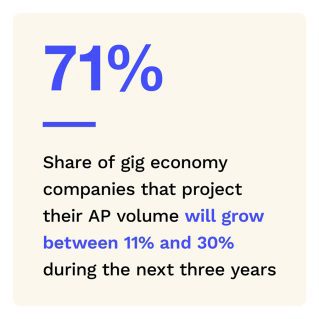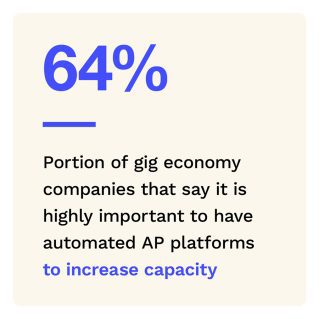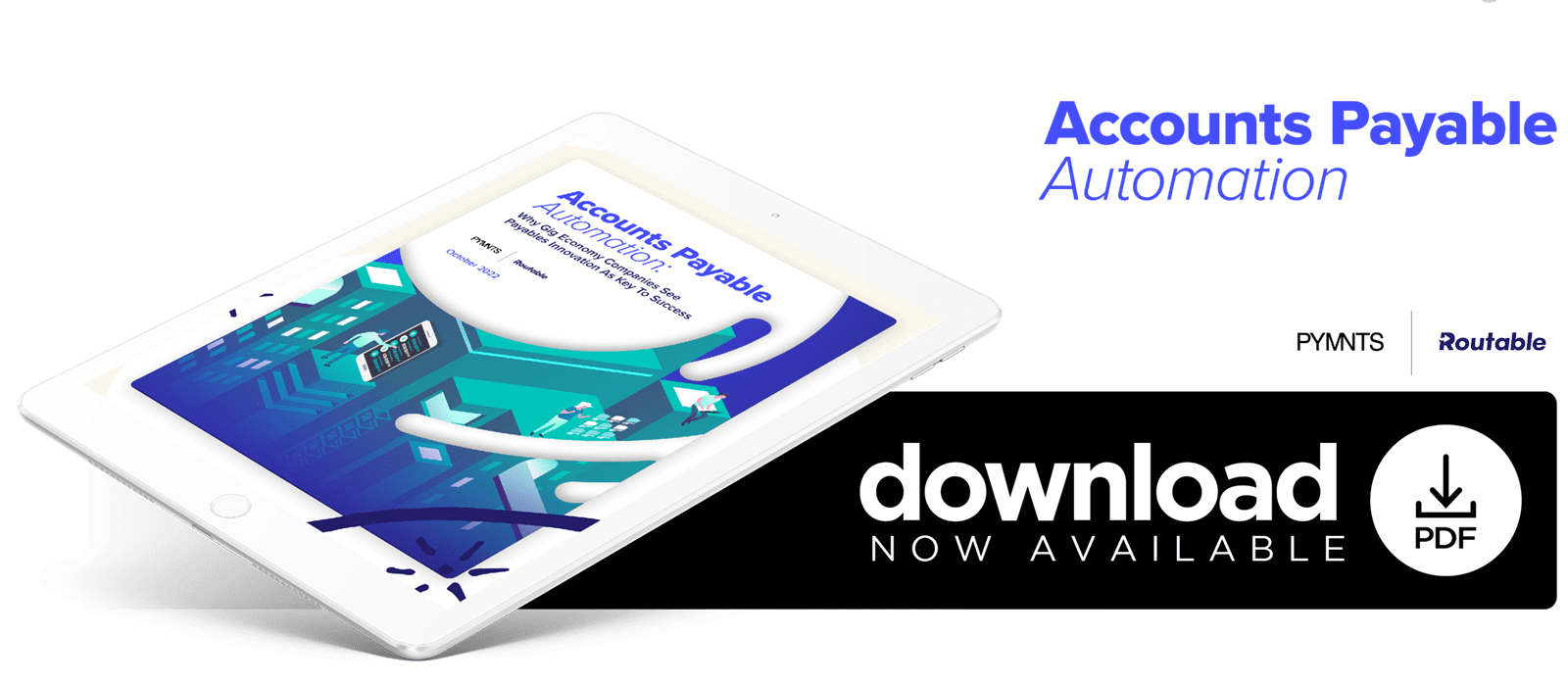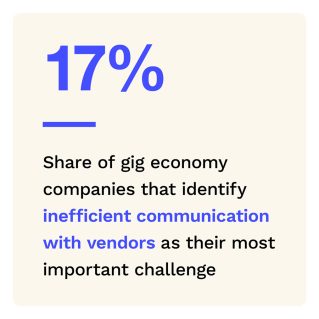Gig Economy Platforms Say Legacy Payments Tech Stalls Future Growth

Gig economy companies have long exhibited rapid growth, and payables volume, particularly, is spiking. Within the industry, 96% of companies experienced an increase in the average number of payables processed each month during the last year.  This growth is expected to continue for the next several years. To ensure that gig economy companies can manage this growth appropriately, many gig economy companies have identified automation of their accounts payable platform as crucial to their continued success.
This growth is expected to continue for the next several years. To ensure that gig economy companies can manage this growth appropriately, many gig economy companies have identified automation of their accounts payable platform as crucial to their continued success.
For “Accounts Payable Automation: Why Gig Economy Companies See Payables Innovation As Key To Success,” a PYMNTS and Routable collaboration, we surveyed 53 executives from gig economy companies to detail how automation of their accounts payable platforms will help them manage their projected growth.
 Findings from the report include:
Findings from the report include:
• Seventy-eight percent of gig economy companies that identify inefficient communications with vendors as a key challenge say it is highly important to automate their AP systems and increase the volume of payments they process.
• Gig economy companies that do not sufficiently value automation of their AP platforms are more likely to experience issues with vendor onboarding than businesses that value automation.
• Seventy-one percent of gig companies planning to innovate with their accounts payable systems say the platform will improve their vendor relationships, which is crucial for the success of their business model.
The gig economy companies that recognize the urgency of innovating with their AP platforms will be in stronger positions than competitors that overlook automation to meet the demands of rapid growth. This report reveals more about what gig economy companies can do to enhance their AP platforms to sustain efficient operations and manage their growth.
To learn more about how gig economy companies are innovating with their accounts payable platforms, download the report.
How the World Does Crypto and What It Means for US Businesses

Cryptocurrency has been synonymous with a lack of regulation and a Wild West ethos.
This has led to speculative and non-core products like meme coins, blockchain games and yesteryear’s NFTs and ICOs.
But all that is beginning to change as regulated economies across the world have started to provide and enact frameworks for integrating digital assets into their financial ecosystems. The European Union’s Markets in Crypto-Assets regulation establishes a clear compliance structure for crypto firms. Meanwhile, in Asia, Singapore’s Payment Services Act offers institutional players a stable environment for participation.
As recently as Wednesday (Feb. 19), Hong Kong announced it was expanding the ways investors can trade digital assets as it looks to position itself as a regulated digital asset hub.
Even Switzerland, long known for its financial conservatism, has made moves in digital asset adoption under the Swiss Distributed Ledger Technology (DLT) Act, which enables tokenized securities and digital asset trading.
Compared to these regulatory advancements, the United States has lagged behind in crafting a unified approach, leaving businesses and banks in a complex regulatory gray zone. However, this does not mean U.S. firms should ignore digital assets, particularly as the regulatory environment softens. Instead, they can take cues from how global peers are using digital assets within regulatory frameworks.
Read also: 5 Blockchain Projects the World’s Biggest Banks Are Behind
A Pragmatic Look at Digital Assets in the Regulated Financial Ecosystem
U.S. financial institutions and payments businesses do not need to reinvent the wheel to integrate digital assets into their domestic financial systems. By observing how regulated economies successfully use digital assets — through tokenization, stablecoins and compliant DeFi models — American businesses and banks can position themselves competitively for the ongoing digital transformation of finance.
Instead of waiting for an all-encompassing regulatory framework, U.S. firms can take a pragmatic, compliance-first approach when investing in such opportunity areas as using stablecoins for payments, exploring asset tokenization and engaging in regulated DeFi experiments.
For example, Standard Chartered Bank Hong Kong, Animoca Brands and HKT agreed Monday (Feb. 17) to form a joint venture to issue a stablecoin backed by the Hong Kong dollar. The three companies have been working together in a Hong Kong Monetary Authority stablecoin issuer sandbox that was launched in July to explore how stablecoins can play a role in the development of financial markets and payments.
In a comparative effort, the U.S. may be months away from seeing the first issuance of a fully reserved, state-specific stablecoin in Wyoming.
“Wyoming doesn’t want to just sort of ‘go along and make sure we’re keeping up,’” Two Ocean Trust CEO and Wyoming Stable Token Commission Commissioner Joel Revill told PYMNTS in an interview posted this month. “We want to lead in this area, pass laws, and set up our regulators to provide clarity that doesn’t exist yet at the federal level or in other states.”
See also: What a B2B Stablecoin Strategy Looks Like
Digital Assets as a Treasury Tool in the Modern Financial Ecosystem
Much of the regulated utility of the crypto space has been within investment-centric areas such as bitcoin and Ethereum ETFs and over-the-counter (OTC) trading desks that include integrated trading, derivatives, lending and qualified custody solutions.
This tendency toward investment products is why PYMNTS covered late last year how blockchain-based treasury applications are important for finance teams looking toward a more efficient and transparent financial future.
Still, many U.S. firms continue to rely on legacy enterprise resource planning and cash management systems that lack native digital asset compatibility.
For treasurers managing complex funding structures, a unified ledger like that provided by on-chain solutions can offer new possibilities for optimizing cash flow and reducing the cost of capital. By embedding compliance and settlement rules directly into digital tokens, organizations can achieve atomic settlement — a simultaneous and instantaneous transfer of funds and assets.
Ultimately, for corporate treasurers, the perspective on digital assets is flipping from a high-risk alternative investment to a liquidity, efficiency and automation tool that can enhance treasury operations.
While U.S. regulatory uncertainty presents challenges, treasurers can look to global case studies for inspiration and begin preparing their treasury functions for a blockchain-based financial future.

